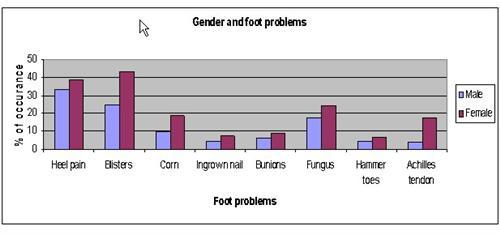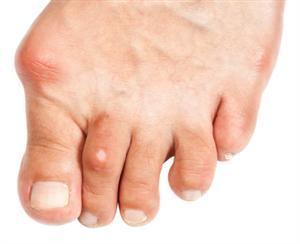| Complexity level: | 4 |
| Project cost ($): | 20 |
| Time required: | 1 day for preparation, 4 days for observation |
| Material availability: | Easily found |
| Safety concerns: | None |
Hypothesis
Women will have more foot problems than men.
Overview
Foot problems
Shoes and other types of footwear are designed for the comfort as well as protection of our feet. However, poorly-fitting and badly designed shoes can cause pain, injury and other problems to the wearer. Some of the common types of foot-related problems include heel pain, blistering, corns and ingrown toenails.
Women tend to experience more foot-related problems due to the wearing of high-heeled shoes. Blistering is among the common problems that women experience when wearing these shoes. This may be caused by the rubbing of the shoe against the skin of the feet, or may be due to excessive pressure exerted on the toes by ill-fitting shoes. Prolonged usage of high-heels also can cause the Achilles tendon to shrink, making it difficult for the wearer to return to wearing flat shoes.
Care must be taken in choosing the right type and size of shoes to wear. The size of our feet will normally change as we grow older, so feet should be measured before selecting shoes. Usually, the size of one foot will be larger than the other; always choose the shoe size into which the larger foot can fit comfortably.
Scientific Terms
Materials
The materials required for the experiment:
- A survey form on feet disorders
- writing materials
Procedure
1. For this experiment, the independent variable is the gender of the participants. The dependent variable is the types of foot problems the participants suffer from. This is determined by asking them to fill in a survey form. The constants (control variables) are the number of questions asked and the age group of the participants.
| Foot problems survey | |||
| Name | Age | Gender | Tick one of the following |
| No | Condition | Yes | No |
| 1 | Heel pain | ||
| 2 | Blisters | ||
| 3 | Corn | ||
| 4 | Ingrown toe nail | ||
| 5 | Bunions | ||
| 6 | Toenail Fungus | ||
| 7 | Hammertoes | ||
| 8 | Achilles tendon |
2. Prepare a survey form listing several types of common foot-related problems. An example of the survey form is shown above. Add more foot-related conditions to the survey form as needed. Make as many copies of the survey form as required.
3. With the help of a few volunteers, survey at least 100 females and 100 men on their foot disorders. They can be students, professionals, housekeepers, farmers and people with other, diverse lifestyles.
4. After collecting all the feedback from the participants, separate and count the number of surveys completed by respondents of each gender. Count the number of males and females suffering from each foot condition as listed in the survey. Next, calculate the proportion of respondents of each gender suffering from each foot problem, as follows:
Percentage of male respondents suffering from foot problem = No. of males suffering from foot problem / Total number of males; or
Percentage of female respondents suffering from foot problem = No. of females suffering from foot problem / Total number of females
Record the results in a table, as shown below.

Results
It was observed that the female participants had a higher incidence of foot problems as compared to the male participants.
| Gender | Percentage of foot-related problems per gender | |||||||
| Heel pain | Blisters | Corn | Ingrown nail | Bunions | Fungus | Hammer toes | Achilles tendon | |
| Male | 33.2 | 24.8 | 9.5 | 4.7 | 6.2 | 17.3 | 4.3 | 3.7 |
| Female | 38.7 | 43.1 | 18.6 | 7.2 | 9.1 | 23.9 | 6.5 | 17.3 |
The above results were then plotted onto a graph, as shown below.

Conclusion
The hypothesis that women will have more foot-related problems compared to men has been proven to be true.
Choosing the right type of footwear and one that fits perfectly is important in caring for our feet. Footwear should be comfortable and not feel tight when worn. Normally, a half to one inch space is needed between our longest toes and the inner edge of the shoe. As we grow older, the size of our feet will change, and we should change our shoes accordingly.
Also consider
Try to repeat the experiment by using participants of different age groups.
The experiment can also be modified to compare the effects of wearing high heels or sandals on women’s feet.
References
Guide to foot care and foot problems - http://arthritis.about.com/od/foot/a/footcare.htm
What are some problems caused by wearing high heels? - http://www.wisegeek.com/what-are-some-problems-caused-by-wearing-high-heels.htm
Five foot problems men should never ignore - http://www.thirdage.com/foot-health/five-foot-problems-men-should-never-ignore

